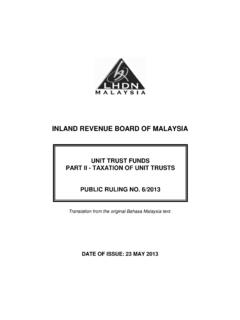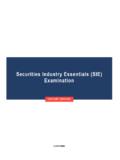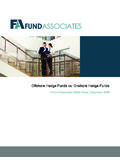Transcription of The Hong Kong Trustees’ Association Best Practice …
1 The Hong kong Trustees Association best Practice guide for Trustees of Corporate Trusts 1st Edition: August 2012 HKTA best Practice guide Corporate Trusts (August 2012) 1 The Hong kong Trustees Association best Practice guide for Trustees of Corporate Trusts Introduction This guide sets out the best practices which aim to educate and raise industry standards of members of the Hong kong Trustees Association ( HKTA ) in relation to their trustee activities for corporate trusts. Corporate trusts, in this context, refer to collective investment schemes in the form of a trust which enable a number of investors to pool their assets and have the pooled assets professionally managed by an independent manager and under which the unitholders are beneficiaries of the relevant corporate trust .
2 It is noted that some corporate trusts are constituted by a declaration of trust (and hence investment powers rest with the trustee and the trustee appoints the investment manager), whilst others are constituted by a 2-party trust deed ( the typical trust deed for a unit trust in which the investment manager has sole power over investments). There may be other forms of corporate trust structures where a trustee is in place and members may exercise their discretion in applying all or certain Principles in this guide as they consider appropriate in the administration of such trusts. This guide therefore needs to be applied appropriately to the constitution of the trust and the resulting responsibility of the trustee . The guide consists of 3 parts: 1. Guiding Principles 2. Guidance Notes, and 3. Practice Guidelines The Guiding Principles When acting as trustee , certain duties and powers are imposed and created pursuant to the provisions of the trust deed, the trustee Ordinance and general common law.
3 The Guiding Principles seek to guide members of the HKTA on how such duties and powers should be discharged and exercised. The application of these general Guiding Principles will vary depending on the particular trust involved and the terms by which that trust is constituted. However, applying these principles when acting as trustee should assist members of the HKTA in meeting their fiduciary obligations. HKTA best Practice guide Corporate Trusts (August 2012) 2 The 9 Guiding Principles are to be observed by and are applicable to all Hong kong trustees of corporate trusts. Guidance Notes The Guidance Notes are designed to provide members with information on how the Guiding Principles may be met. These Notes should not be treated as definitive guidance and should be applied or adopted as appropriate and as required in the circumstances taking into account the scope and nature of the trustee activities being undertaken.
4 The Guidance Notes are not intended to convey or mandate the only way to address a particular issue. Practice Guidelines Practice Guidelines may be issued under this guide from time to time to provide members with suggestions on how the Guiding Principles in relation to particular areas of Practice may be met. Practice guidelines will be more detailed than Guidance Notes and cover more practical issues. Practice Guidelines should not be treated as a definitive guide to a particular Practice area and should be applied or adopted as appropriate and as required in the circumstances given the scope and nature of the trustee activities being undertaken. Practice Guidelines are not intended to convey or mandate the only way to address a particular issue. Review of and Changes to the guide The Guides will be regularly reviewed by the best practices Sub-committee.
5 Any change to this guide requires the approval, by majority resolution, by the members of the HKTA Executive Committee. Any proposed change will be circulated in advance to members for consultation and all views will be taken into account by the Executive Committee when considering the implementation of any such change. Conflict between the guide and other Codes In the event of any conflict between this guide and any laws, regulations, codes or guidelines (including codes of conduct) (collectively Other Codes ) issued by a regulatory or professional statutory body to which a trustee may be subject, the Other Codes will take precedence. However, in all cases, a trustee should seek to resolve any conflict taking into account the Guiding Principles. HKTA best Practice guide Corporate Trusts (August 2012) 3 Important Note The HKTA does not accept, and hereby expressly disclaims, all and any responsibility and liability of any nature whatsoever, including liability for loss or damage, for the consequences, direct or indirect, of any act or omission on the part of any of its members or any other person, whether negligent or fraudulent or otherwise, and whether in breach of trust or not, in observing and performing or failing to observe or perform any of the provisions or principles of this guide (and any changes thereto) and all Practice Guidelines that may be issued thereunder.
6 Furthermore, it should not be inferred or understood from the adoption by any member of the HKTA or any other person of this guide or of the standards of Practice herein contained or of the Guiding Principles contained herein, or from any statement by any such member or person that such member or person will or intends to observe and perform such standards of Practice or Guiding Principles, that the HKTA endorses such member or other person or the standard of performance or otherwise of such member or other person in the conduct of such member's or other person's activities as trustee . 2012 Hong kong Trustees' Association Limited ("HKTA"). All rights reserved. No part of this document may be reprinted or reproduced (whether in whole or in part) or applied for any unauthorized use without the prior written consent of the HKTA. HKTA best Practice guide Corporate Trusts (August 2012) 4 GUIDING PRINCIPLES 1.
7 Act in Good Faith 2. Act with Prudence and Care 3. Act with Skill and Diligence 4. Act with Integrity and Independence 5. Maintain Confidentiality 6. Comply with Applicable Laws and Regulations 7. Communicate Effectively in a Transparent Manner 8. Promote the Highest Standards of Governance 9. Act in Accordance with trust Objects HKTA best Practice guide Corporate Trusts (August 2012) 5 GUIDANCE NOTES Principle 1: Act in Good Faith. Acting in good faith and in the best interests of investors/beneficiaries in accordance with the objects of the trust . Acting in the best interests of the investors/beneficiaries in this context includes: x Balancing Objectives. In case where the trust is constituted by a declaration of trust : Striving for a balance between the objects of the trusts, such as to (i) maximize long term asset growth, (ii) minimize management costs, (iii) minimize risk, and (iv) make payments to investors in a timely manner.
8 In certain trust arrangements such as unit trusts, the balancing of investment objectives will be the responsibility of the appointed investment manager. x Acting in the Investors/Beneficiaries Interest. (a) In cases where the trust is constituted by a declaration of trust : The trustee should consider the impact of decisions relating to the trust on the wider community. Wider community interests may include taking into account socially responsible management philosophies when selecting investments and ensuring responsible selling practices . However, in all cases, the interests of the investors/beneficiaries must remain paramount. (b) Where the trust is constituted by a 2-party trust deed ( unit trust ): The trustee should administer the trust impartially in the interests of the investors/beneficiaries with diligence and in good faith, according to the terms of the trust deed and/or the applicable regulations.
9 X Disclosure and Transparency. (a) In cases where the trust is constituted by a declaration of trust : Maintaining and disclosing a clear statement of the risks and objectives of the trust together with a transparent fee structure. Ensuring that fees are fair and reasonable. (b) Where the trust is constituted by a 2-party trust deed: Ensuring that the fees of the trustee s delegates and agents are fair and reasonable. HKTA best Practice guide Corporate Trusts (August 2012) 6 Principle 2: Act with Prudence and Care. Acting with prudence and reasonable care in the performance of your duties. In considering what is reasonable , you need to consider what a person acting in the same capacity and with the same objectives would do under the same circumstances. Acting with Prudence includes: x Being Informed.
10 Acting on a fully informed basis, and actively participating in discussions and decision making on matters over which the trustee has discretion under the trust constitutive documents. x Risk Management. Policies and procedures to assist in identifying and managing risks proactively, consistently and in a timely manner and detailing the internal controls in place to mitigate particular risks. x Seeking Assistance. Seeking external professional help whenever additional expertise is required. x Client Due Diligence (CDD) and AML Provisions. Policies and procedures should be in place for compliance with the principles set out in the applicable laws and regulations. Acting with care includes a number of facets: x Good Faith. Acting with proper motive and purpose. x Consistency. Exercising power and discretion consistently. To the extent that any decision constitutes a departure from agreed Practice or procedure, you should be able to show that the decision was reasonable in the circumstances.






